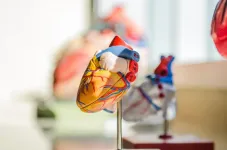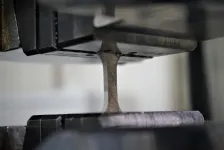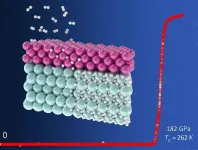Choose life: Why patients in China refuse standard treatment for a type of heart attack
Scientists identify numerous variables that predict the treatment decisions of patients with a type of heart attach called ST-elevation myocardial infarction
2021-03-31
(Press-News.org) ST segment-elevation myocardial infarction (STEMI) is a particularly severe type of heart attack associated with a high risk of mortality or long-term disability. Clinicians can reduce a patient's chances of unfavorable outcomes by performing a procedure known as percutaneous coronary intervention (PCI), which combines coronary angioplasty--in which a balloon is inserted into a blocked artery of the heart to clear it--with stenting--inserting a tiny tube into a blocked artery to keep the line open. But studies in China have found that many patients with STEMI choose not to undergo PCI and that women with STEMI, in particular, have a reduced likelihood of undergoing guideline-based management and acute reperfusion therapy.
The phenomenon of patients with STEMI refusing PCI attracted the interest of a research team at China's Shandong University. As lead researcher of the team, Dr. Yu-Guo Chen explains, "Understanding the factors that influence patients' decisions to reject medical advice may facilitate efforts to improve treatment compliance, quality of care, and prognoses." Dr. Chen and team conducted analyses of treatment data to identify the predictors of PCI refusal for patients with STEMI. Their results appear in a paper published in a recent edition of the Chinese Medical Journal.
For their analyses, the researchers used data that had been prospectively collected through a cohort study involving patients with STEMI who presented to any of six Chinese emergency departments between August 2015 and September 2017. After excluding patients who never had the opportunity to decide whether to undergo PCI, as well as patients transferred to other hospitals and those discharged against the treating clinicians' advice, the researchers had a dataset of 957 patients, including 260 women and 697 men. On this dataset, they used multivariable logistic regression analyses to identify the predictors of PCI refusal.
In total, 98 of the patients in the dataset (10.2%) chose not to undergo PCI. One factor that had a major influence on their decisions was age, with patients older than 65 years being more likely than their younger counterparts to refuse PCI. Some important predictors of PCI refusal were having a history of myocardial infarction, experiencing cardiac shock while in the emergency department, a more than 12-hour delay in reaching the hospital after STEMI onset, and having a faster heart rate.
Some other factors included being married, receiving treatment at a tertiary hospital, and having a higher body mass index value.
Interestingly, comparisons between male and female patients showed that female patients were older, were less likely to be married, had lower body mass index values on average, and were less likely to receive treatment at tertiary hospitals. Given that these factors were all predictors of PCI refusal in the regression model, these differences may help to explain why women with STEMI are more likely to refuse PCI than their male counterparts are.
In conclusion, the researchers at Shandong University have identified a host of factors that may help to predict whether a patient with STEMI will give or withhold consent to PCI. When asked about the long-term medical and societal importance of these findings, Dr. Chen notes that knowledge of these predictors may aid healthcare providers in their efforts to persuade more patients with STEMI to consent to PCI. He predicts that increasing the number of patients who undergo PCI "will lead to reductions in mortality and improvements in long-term clinical outcomes." Given the sex disparities in PCI refusal rates, such improvements may be of particular value to Chinese women.
Percutaneous coronary intervention is the recommended procedure after ST-elevation myocardial infarction, but some patients refuse to undergo it. Researchers from Shandong University, China, have identified some demographic and clinical features associated with such treatment refusal.
INFORMATION:
Photo courtesy: Jesse Orrico on Unsplash
Reference
Titles of original papers: Analysis of potential factors contributing to refusal of invasive strategy after ST-segment elevation myocardial infarction in China.
Journal: Chinese Medical Journal
DOI:10.1097/CM9.0000000000001171
[Attachments] See images for this press release:

ELSE PRESS RELEASES FROM THIS DATE:
2021-03-31
By harvesting energy from their surrounding environments, particles named 'artificial micromotors' can propel themselves in specific directions when placed in aqueous solutions. In current research, a popular choice of micromotor is the spherical 'Janus particle' - featuring two distinct sides with different physical properties. Until now, however, few studies have explored how these particles interact with other objects in their surrounding microenvironments. In an experiment detailed in EPJ E, researchers in Germany and The Netherlands, led by Larysa Baraban at Helmholtz-Zentrum Dresden-Rossendorf, show for the first time how the velocities of Janus particles relate to the physical properties of nearby barriers.
The team's discoveries could help researchers to engineer micromotors which ...
2021-03-31
Children with a common but regularly undiagnosed disorder affecting their language and communication are likely to be finding the transition back to school post-lockdown harder than most, according to a team of psychologists.
Two children in every class of 30 are estimated to have Developmental Language Disorder (DLD) (around 8%), yet public awareness, diagnosis and referral to speech and language therapists all remain low in the UK.
DLD is a condition where children have problems acquiring their own language for no obvious reasons. Unlike temporary language delay (which reflects the natural variation of age at which children learn to speak and communicate), DLD is a lifelong condition with significant impacts for individuals in childhood and in later life, in particular their ...
2021-03-31
Lakes store huge amounts of methane. In a new study, environmental scientists at the University of Basel offer suggestions for how it can be extracted and used as an energy source in the form of methanol.
Discussion about the current climate crisis usually focuses on carbon dioxide (CO2). The greenhouse gas methane is less well known, but although it is much rarer in the atmosphere, its global warming potential is 80 to 100 times greater per unit.
More than half the methane caused by human activities comes from oil production and agricultural fertilizers. But the gas is also created by the natural decomposition of biomass by ...
2021-03-31
Scientists from Trinity College Dublin believe they have pinpointed our most distant animal relative in the tree of life and, in doing so, have resolved an ongoing debate. Their work finds strong evidence that sponges - not more complex comb jellies - were our most distant relatives.
Sponges are structurally simple, lacking complex traits such as a nervous system, muscles, and a though-gut. Logically, you would expect these complex traits to have emerged only once during animal evolution - after our lineage diverged from that of sponges - and then be retained in newly evolved creatures thereafter.
However, a debate has been raging ever since phylogenomic studies found evidence that our most distant ...
2021-03-31
Superalloys that withstand extremely high temperatures could soon be tuned even more finely for specific properties such as mechanical strength, as a result of new findings published today.
A phenomenon related to the invar effect - which enables magnetic materials such as nickel-iron (Ni-Fe) alloys to keep from expanding with increasing temperature - was reported to have been discovered in paramagnetic, or weakly magnetized, high-temperature alloys.
Levente Vitos, Professor at KTH Royal Institute of Technology in Stockholm, says the breakthrough research, which includes a general theory explaining the new invar effect, promises to advance the design of high-temperature alloys with exceptional mechanical stability. The article was published in the Proceedings ...
2021-03-31
The higher the number of plant and bird species in a region, the healthier the people who live there. This was found by a new study published in Landscape and Urban Planning and led by the German Centre for Integrative Biodiversity Research (iDiv), the Senckenberg Biodiversity and Climate Research Centre (SBiK-F) and the Christian Albrechts University (CAU) in Kiel. The researchers found that, in particular, mental health and higher species diversity are positively related, whereas a similar relationship between plant or bird species and physical health could not be proven.
The study led by researchers from iDiv, SBiK-F and CAU provides ...
2021-03-31
University of Rochester researchers who demonstrated superconducting materials at room temperatures last fall, now report a new technique in the quest to also create the materials at lower pressures.
In a paper published in Physical Review Letters, the lab of Ranga Dias, assistant professor of mechanical engineering and of physics and astronomy, describes separating hydrogen atoms from yttrium with a thin film of palladium.
"This is a completely new technique that nobody has used before for high pressure superhydride synthesis," Dias says.
Hydrogen rich materials are critical in the ...
2021-03-31
As with any complex machine, sometimes a simple crossed wire or short circuit can cause problems with how it functions. The same goes for our brains, and even when the short circuit is uncovered, sometimes experts don't have a quick fix.
A new study reveals that an evidence-based treatment may "fix" this human short circuit and, with the help of brain imaging, might predict treatment outcomes for adolescents with anxiety disorders. University of Cincinnati researchers say this could determine medication effectiveness more quickly to help patients.
Study results showed that brain imaging was able to predict -- after just two weeks of treatment ...
2021-03-31
A targeted opioid that only treats diseased tissues and spares healthy tissues relieves pain from inflammatory bowel disease without causing side effects, according to new research published in the journal Gut.
The study, led by researchers at New York University College of Dentistry and Queen's University in Ontario, was conducted in mice with colitis, an inflammatory bowel disease marked by inflammation of the large intestine.
Opioids, which are used to treat chronic pain in people with inflammatory bowel disease, relieve pain by targeting opioid receptors, including the mu opioid receptor. When opioids activate the mu opioid receptor in healthy ...
2021-03-31
A team from the Universitat Politècnica de València (UPV) and the CIBER Bioengineering, Biomaterials and Nanomedicine (CIBER-BBN) has designed and tested, at a preclinical level, a new biomaterial for the treatment and recovery of muscle injuries. It is a boron-loaded alginate hydrogel, which would be administered with a subcutaneous injection. According to the tests carried out so far -in animal models-, it is capable of regenerating damaged muscle very rapidly -specifically, in half the time it takes for it to regenerate naturally.
The scientific advance could also be applied to the prevention and treatment of muscle atrophy associated with aging. The results of the work of these Spanish researchers have been published in the journal Materials Science & Engineering C.
The ...
LAST 30 PRESS RELEASES:
[Press-News.org] Choose life: Why patients in China refuse standard treatment for a type of heart attack
Scientists identify numerous variables that predict the treatment decisions of patients with a type of heart attach called ST-elevation myocardial infarction





